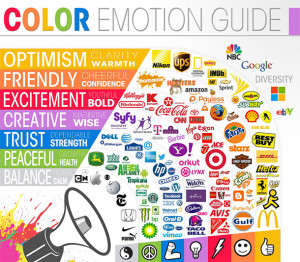There are several studies which argue that different colors affect our psychology. Colors appear to invoke certain emotion in people; some of these emotions include fear, sadness, and happiness. Research has shown that people associate colors with certain personal experiences, memories, and relationships and these factors decide these people’s relationships with and perceptions of colors. For instance, studies state that yellow seems to be the “happiest” color on the spectrum which is most likely the reason that pencils are painted such color.

Colors affect mood and branding. (Source)
Besides psychology, how do colors affect branding? If you examine the “color emotion guide,” you will see which colors we as consumers typically associate with emotions. For example, yellow might translate for most to warmth and clarity while red might produce feelings of excitement and boldness. These typical responses to these colors are possible reasons why companies choose these colors for their logos. For consumers, logo colors very well might determine how they feel about products, services, and companies.
In fact, in a recent color marketing study, 90% of the initial or snap judgements that consumers made were based on solely color. Consumers also judge products and services based on if their perception of the color matches what the products or services provides. In other words, consumers are more likely to buy products or believe in companies that incorporate what they find are the appropriate colors. Basically consumers pair specific colors with their perceptions of what a brand should be; therefore, colors and branding go hand in hand.
Companies should take into consideration which colors consumers would naturally associate with their brands in order to reel in as many buyers as possible. Psychologists have researched the 5 main traits which brand personalities usually focus on. These are; sincerity, excitement, competence, sophistication, and ruggedness. Colors do align with these traits. For instance, consumers normally pair the color brown with a rugged quality.
Color seems to greatly affect a brand’s ability to successfully persuade. Color affects mood and immediate emotions which in turn determines how a consumer initially feels about a product. Color can alter mood and overall transform a consumer’s experience with a product whether positive or negative. Thus, the correlation between color and brand persuasion is a true indication of whether a consumer buys a product or believes in the services of a company.
(Youtube)
